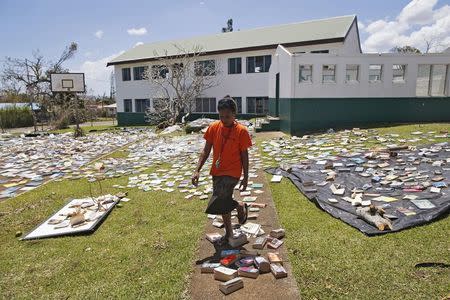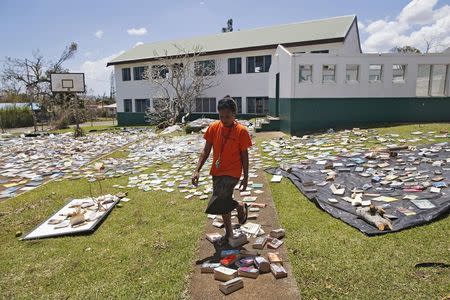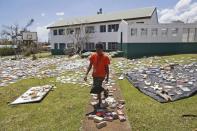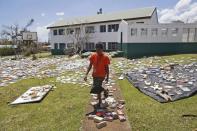South Pacific's Vanuatu provides lessons in cyclone survival
By Stephen Coates and Lincoln Feast
PORT VILA/SYDNEY (Reuters) - Villagers in Vanuatu buried food and fresh water as one of the strongest storms on record bore down on them, fleeing to churches, schools and even coconut drying kilns as 300 kph winds and massive seas tore their flimsy houses to the ground.
Despite reports of utter devastation six days after Cyclone Pam pummelled the impoverished South Pacific island nation, Vanuatu appears to be providing something of a lesson in how to survive a category 5 storm.
The United Nations says the official death toll is 11. Many officials anticipate that number will rise once they are able to more thoroughly inspect the outer islands of the scattered archipelago.
Still, the absence of a much higher toll has amazed aid workers and those who lived through it.
"It's absolutely unbelievable the death toll is so low," said Richard Barnes, 43, a property valuer from New Zealand who has lived near the capital Port Vila, on Efate island for seven years.
Two days ago, a helicopter flight over the north of Efate revealed scenes of total devastation with at least one coastal village destroyed and no sign of life.
When visited a day later, dozens of villagers were back rebuilding with what materials they could find and reporting only one injury, said Barnes, who was on Cayman Island in 2004 when Hurricane Ivan hit.
"Everyone is just getting on with it, which was different from Cayman where everyone just sat around waiting for something to be done," Barnes said.
Sebastian Rhodes Stampa, disaster co-ordinator for the U.N.'s humanitarian affairs office, agreed.
"In very few places that I have worked have I seen such a resilient population," Rhodes Stampa, who has worked in major disaster sites including the Philippines after Typhoon Haiyan, told Reuters in Port Vila.
BURIED FOOD
Perched on the geologically active "Ring of Fire", Vanuatu suffers from frequent earthquakes and tsunamis and has several active volcanoes, in addition to threats from storms and rising sea levels.
Ben Hemingway, a regional adviser for USAid, said aid organisations like his had been working with the Vanuatu government for years on disaster mitigation.
"It's a testament to the investment the international community has made. If you look at the days before the storm, the message got out on the power of the storm and what to do to protect yourself. People did heed those warnings."
Many villages are built further back from the shore to avoid storm surges and tsunamis, and most have at least one sturdy building to retreat to. Even the spreading roots of banyan trees that have survived centuries of storms are also sometimes used as shelter if houses are destroyed.
"Community level disaster risk reduction is as easy as giving people good information, basic skills to make their traditional structures more safe and to know what to do in the immediate aftermath," Hemingway said.
"It saves lives and gives us time as the international community responds."
Some villagers survived Pam by sheltering in a kiln used to dry coconuts and make copra, one aid official said.
With a strong early warning system and a population well used to cyclones, people in the capital Port Vila prepared by weighing down corrugated tin roofs with cinder blocks, sandbags or logs. On small isolated islands, stock piles of coconuts, fruit and water were buried to enable villagers to survive several days, residents and aid workers said.
Latrines are dug ahead of storms and lined with palm fronds to prevent contamination of water supplies.
Vanuatu, one of the world's poorest nations, is a sprawling cluster of more than 80 islands and 260,000 people, 2,000 km (1,250 miles) northeast of the Australian city of Brisbane.
Aid workers are now trying to get aid to isolated islands where airstrips, ports and communications are extensively damaged. Two helicopters were onboard a French frigate leaving nearby New Caledonia on Thursday.
Near Port Vila, shopkeeper Diana Varu, 40, survived by running from house to house as winds tore the roofs off, finally sheltering with her two children and 16 others in a neighbour's home.
"I've never seen a storm like that. My nine-year old boy Sam panicked and cried," she said.
(Editing by Rachel Armstrong)











